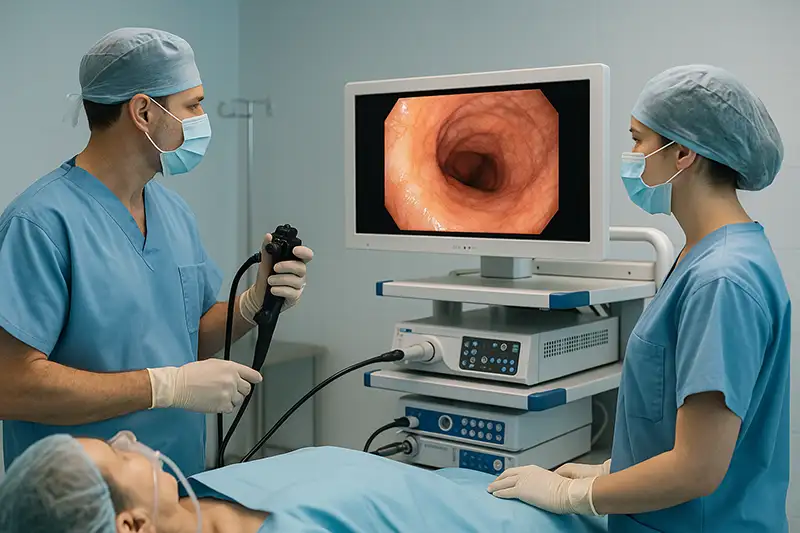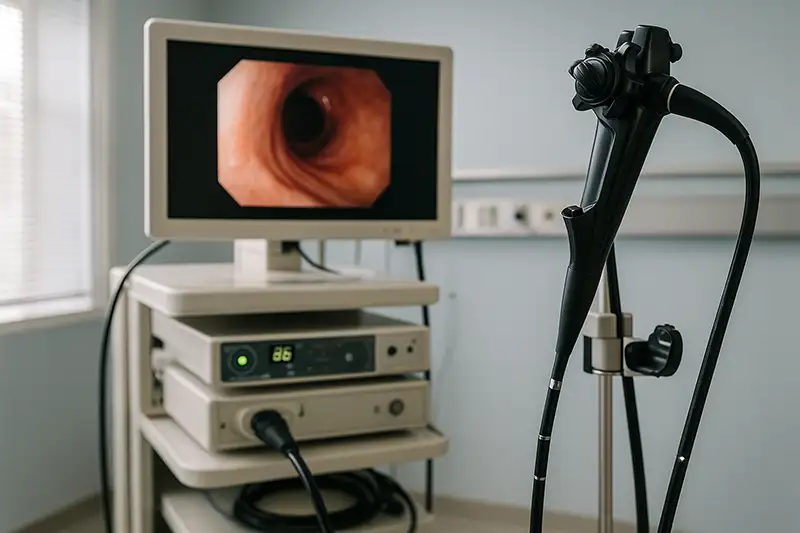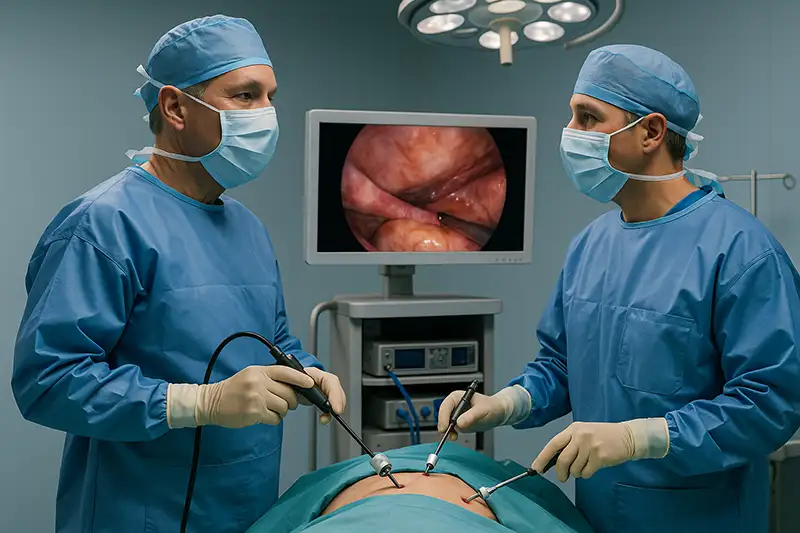តារាងមាតិកា
ប្រព័ន្ធ Endoscopic គឺជាឧបករណ៍វេជ្ជសាស្ត្រដែលប្រើវិសាលភាពដែលអាចបត់បែនបាន ឬរឹងជាមួយនឹងពន្លឺ និងកាមេរ៉ា ដើម្បីមើលឃើញផ្នែកខាងក្នុងនៃរាងកាយ។ វាជួយវេជ្ជបណ្ឌិតក្នុងការធ្វើរោគវិនិច្ឆ័យ និងព្យាបាលលក្ខខណ្ឌតាមរយៈការវះកាត់តូចៗ ឬការបើកដោយធម្មជាតិ កាត់បន្ថយការប៉ះទង្គិច ភាពស្មុគស្មាញ និងរយៈពេលនៃការស្តារឡើងវិញ បើប្រៀបធៀបជាមួយនឹងការវះកាត់បើកចំហ។
ការថតកាំរស្មីអ៊ិចបានផ្លាស់ប្តូរទេសភាពនៃឱសថទំនើប។ មុនពេលការវិវឌ្ឍន៍របស់វា គ្រូពេទ្យពឹងផ្អែកលើការវះកាត់បើកចំហរ ឬបច្ចេកទេសថតរូបភាពដោយប្រយោល ដែលផ្តល់ព័ត៌មានមានកម្រិត។ ជាមួយនឹងការកើនឡើងនៃខ្សែកាបអុបទិក និងកាមេរ៉ាខ្នាតតូច ការថតឆ្លុះបានក្លាយទៅជាវិធីសាស្ត្រសុវត្ថិភាព និងច្បាស់លាស់ជាងមុន ដើម្បីមើលខាងក្នុងរាងកាយរបស់មនុស្ស។
នៅពាក់កណ្តាលសតវត្សរ៍ទី 20 អង់ដូស្កុបកាន់តែអាចទុកចិត្តបាន និងអនុញ្ញាតឱ្យមានដំណើរការធម្មតានៅក្នុងជំងឺក្រពះពោះវៀន។ យូរៗទៅ ភាពជឿនលឿននៃបច្ចេកវិទ្យាបានពង្រីកការប្រើប្រាស់របស់ពួកគេទៅជាផ្នែក orthopedics, gynecology, pulmonology, និង urology ។ សព្វថ្ងៃនេះ ប្រព័ន្ធ Endoscopic គឺមិនអាចខ្វះបាននៅក្នុងមន្ទីរពេទ្យនៅទូទាំងពិភពលោក ដោយគាំទ្រអ្វីៗគ្រប់យ៉ាងចាប់ពីការពិនិត្យការពារមហារីក រហូតដល់អន្តរាគមន៍សង្គ្រោះជីវិត។
សារៈសំខាន់នៃការថតឆ្លុះមិនត្រូវបានកំណត់ចំពោះរោគវិនិច្ឆ័យទេ។ វាក៏គាំទ្រដល់ការវះកាត់រាតត្បាតតិចតួចផងដែរ ដែលផ្តល់នូវការជាសះស្បើយលឿនជាងមុន ការឈឺចាប់ក្រោយការវះកាត់តិច និងហានិភ័យទាបបើធៀបនឹងវិធីសាស្ត្រប្រពៃណី។ សម្រាប់អ្នកជំងឺ នេះមានន័យថាកាត់បន្ថយការស្នាក់នៅក្នុងមន្ទីរពេទ្យ និងគុណភាពជីវិតកាន់តែប្រសើរឡើង។
ប្រព័ន្ធ Endoscopic មិនមែនជាឧបករណ៍តែមួយទេ ប៉ុន្តែជាការប្រមូលផ្ដុំនៃផ្នែកអាស្រ័យគ្នាដែលធ្វើការជាមួយគ្នាដើម្បីបង្កើតលទ្ធផលច្បាស់លាស់ ត្រឹមត្រូវ និងអាចធ្វើសកម្មភាពបាន។ ការយល់ដឹងអំពីសមាសធាតុទាំងនេះជួយបង្ហាញអំពីមូលហេតុដែលការថតកាំរស្មីអ៊ិចមានប្រសិទ្ធភាពខ្លាំង។
Endoscope ខ្លួនវាអាចបត់បែនបាន ឬរឹង ដែលរចនាឡើងតាមតម្រូវការរបស់គ្លីនិក។ វិសាលភាពដែលអាចបត់បែនបានគឺចាំបាច់សម្រាប់ការរុករកខ្សែកោងនៃការរលាកក្រពះពោះវៀន ខណៈដែលវិសាលភាពរឹងគឺសមស្របជាងសម្រាប់ការវះកាត់រួមគ្នា ឬការវះកាត់ពោះ។ ទាំងពីរត្រូវតែមានតុល្យភាពរវាងភាពបត់បែនជាមួយនឹងភាពច្បាស់លាស់នៃរូបភាព។
ប្រភពពន្លឺ និងឯកតារូបភាពគឺសំខាន់ដូចគ្នា។ អំពូល LED និង xenon ផ្តល់ពន្លឺខ្លាំងគ្រប់គ្រាន់ដើម្បីបំភ្លឺ បែហោងធ្មែញជ្រៅ ដោយមិនមានជាលិកាឡើងកំដៅ។ កាមេរ៉ាចាប់យកពន្លឺដែលឆ្លុះបញ្ចាំង និងបញ្ជូនរូបភាពនិយមន័យខ្ពស់ទៅកាន់ម៉ូនីទ័រ ដែលគ្រូពេទ្យអាចមើលឃើញរចនាសម្ព័ន្ធក្នុងពេលជាក់ស្តែង។ គ្រឿងបន្ថែមដូចជា biopsy forceps, អន្ទាក់ ឬឧបករណ៍ថាមពល—បំលែងប្រព័ន្ធពីឧបករណ៍វិនិច្ឆ័យទៅជាឧបករណ៍ព្យាបាល។
វិសាលភាព៖ អាចបត់បែនបានសម្រាប់ GI និងការប្រើប្រាស់សួត; រឹងសម្រាប់ laparoscopy និងarthroscopy.
ប្រភពពន្លឺ៖ LED ឬ xenon ជួនកាលមានរូបភាពតូចចង្អៀត ដើម្បីរំលេចព័ត៌មានលម្អិតនៃជាលិកា។
ឯកតារូបភាព៖ ឧបករណ៍ចាប់សញ្ញា 4K ដែលមាននិយមន័យខ្ពស់ និងប្រព័ន្ធដំណើរការឌីជីថលសម្រាប់ភាពច្បាស់លាស់។
ការបង្ហាញ៖ ម៉ូនីទ័រកម្រិតវេជ្ជសាស្ត្រ ជួនកាល 3D សម្រាប់ភាពជាក់លាក់ក្នុងពេលវេលាជាក់ស្តែង។
មុខងារនៃប្រព័ន្ធ endoscopic ពឹងផ្អែកលើពន្លឺ អុបទិក និងដំណើរការឌីជីថល។ វិសាលភាពត្រូវបានបញ្ចូលតាមរយៈការបើកធម្មជាតិ (ដូចជាមាត់ ច្រមុះ ឬបង្ហួរនោម) ឬស្នាមវះតូច។ ពន្លឺបំភ្លឺជាលិកាខាងក្នុង ខណៈពេលដែលកាមេរ៉ានៅផ្នែកចុងនៃវិសាលភាពចាប់យករូបភាពដែលត្រូវបានបញ្ជូនទៅខួរក្បាលខាងក្រៅ។
បច្ចេកវិទ្យាឌីជីថលដើរតួនាទីយ៉ាងសំខាន់។ កម្មវិធីកែសំរួលពន្លឺ ពណ៌ និងភាពច្បាស់ដោយស្វ័យប្រវត្តិ ដែលអនុញ្ញាតឱ្យគ្រូពេទ្យមើលឃើញព័ត៌មានលម្អិតដែលមើលមិនឃើញដោយភ្នែកទទេ។ នៅក្នុងប្រព័ន្ធមួយចំនួន AI algorithms ជួយដោយដាក់ស្លាកស្នាមរបួសដែលគួរអោយសង្ស័យ ឬវាស់ទំហំក្នុងពេលវេលាជាក់ស្តែង។
នៅក្នុងការអនុវត្ត ការថតឆ្លុះមិនត្រូវបានកំណត់ចំពោះការមើលនោះទេ។ ឆានែលការងារនៃវិសាលភាពអនុញ្ញាតឱ្យមានការណែនាំឧបករណ៍។ ការធ្វើកោសល្យវិច័យអាចត្រូវបានគេយក ការរីកលូតលាស់ត្រូវបានយកចេញ ការគ្រប់គ្រងការហូរឈាម និងសូម្បីតែការជួសជុលស្មុគស្មាញបានបញ្ចប់ក្នុងអំឡុងពេលវគ្គតែមួយ។ សមត្ថភាពក្នុងការផ្សំការធ្វើរោគវិនិច្ឆ័យជាមួយនឹងការព្យាបាលធ្វើឱ្យការថតឆ្លុះឆ្លុះមានប្រសិទ្ធភាព និងងាយស្រួលសម្រាប់អ្នកជំងឺ។
ភាពប៉ិនប្រសប់នៃប្រព័ន្ធ endoscopic ពន្យល់ពីការទទួលយករបស់ពួកគេនៅទូទាំងផ្នែកវេជ្ជសាស្រ្តជាច្រើន។ ឯកទេសនីមួយៗសម្របប្រព័ន្ធស្នូលទៅនឹងបញ្ហាប្រឈមរបស់ខ្លួន។
ក្នុងផ្នែកក្រពះពោះវៀន ការថតឆ្លុះចុងក្រោយគឺជាគ្រឹះមួយ។ Gastroscopy អនុញ្ញាតឱ្យមើលឃើញពីបំពង់អាហារ និងក្រពះ រកមើលដំបៅ ហូរឈាម ឬដុំសាច់។ ការឆ្លុះពោះវៀនធំត្រូវបានប្រើប្រាស់យ៉ាងទូលំទូលាយសម្រាប់ការពិនិត្យរកជំងឺមហារីក ខណៈពេលដែលការឆ្លុះពោះវៀនធំរុករកពោះវៀនតូច។ នីតិវិធីទាំងនេះគឺជាចំណុចកណ្តាលនៃការរកឃើញ ការការពារ និងការព្យាបាលទាន់ពេលវេលា។
គ្រូពេទ្យវះកាត់ឆ្អឹងប្រើ arthroscopy ដើម្បីវាយតម្លៃ និងជួសជុលសន្លាក់។ តាមរយៈស្នាមវះតូចៗ ពួកគេអាចវាយតម្លៃឆ្អឹងខ្ចី សរសៃចង និងជាលិកា synovial ។ វិធីសាស្រ្តនេះកាត់បន្ថយពេលវេលានៃការងើបឡើងវិញធៀបនឹងការវះកាត់រួមគ្នាដោយបើកចំហ ដែលធ្វើឱ្យវាក្លាយជាស្តង់ដារមាសសម្រាប់អត្តពលិក និងបុគ្គលសកម្ម។
នៅក្នុងរោគស្ត្រី ការថតឆ្លុះអាចឱ្យគ្រូពេទ្យមើលស្បូន កំណត់អត្តសញ្ញាណដុំសាច់ ដុំពក ឬភាពមិនប្រក្រតីនៃរចនាសម្ព័ន្ធ។ អ្នកជំនាញខាង urologist ប្រើ cystoscopy សម្រាប់លក្ខខណ្ឌប្លោកនោម។ គ្រូពេទ្យសួតពឹងផ្អែកលើ bronchoscopes ដើម្បីធ្វើរោគវិនិច្ឆ័យការឆ្លងមេរោគ និងដុំសាច់ក្នុងសួត។ អ្នកឯកទេស ENT ប្រើការថតចម្លងច្រមុះសម្រាប់ជំងឺប្រហោងឆ្អឹងរ៉ាំរ៉ៃ និង laryngoscopy សម្រាប់បញ្ហាសំលេង។
រួមគ្នា កម្មវិធីទាំងនេះបង្ហាញថាប្រព័ន្ធ endoscopic មិនត្រូវបានកំណត់ចំពោះផ្នែកឱសថមួយមុខនោះទេ ប៉ុន្តែជាឧបករណ៍ចាំបាច់នៅទូទាំងស្ទើរតែគ្រប់ឯកទេសទាំងអស់។
អត្ថប្រយោជន៍នៃការថតឆ្លុះគឺមានសារៈសំខាន់សម្រាប់ទាំងអ្នកជំងឺ និងប្រព័ន្ធថែទាំសុខភាព។
ស្នាមវះតូចកាត់បន្ថយរបួស។
អ្នកជំងឺមានការឈឺចាប់ក្រោយការវះកាត់តិចជាង។
លទ្ធផលកែសម្ផស្សគឺប្រសើរជាងដោយសារការកាត់បន្ថយស្លាកស្នាម។
នីតិវិធី endoscopic ជាច្រើនគឺផ្អែកលើអ្នកជំងឺក្រៅ។
អ្នកជំងឺត្រឡប់ទៅសកម្មភាពប្រចាំថ្ងៃកាន់តែលឿន។
មន្ទីរពេទ្យអាចព្យាបាលអ្នកជំងឺបានច្រើនដោយមានគ្រែតិច។
ហានិភ័យទាបនៃការឆ្លង និងផលវិបាក។
ការពឹងផ្អែកតិចលើថ្នាំបំបាត់ការឈឺចាប់អាភៀន។
កាត់បន្ថយការចំណាយសរុបសម្រាប់មន្ទីរពេទ្យ និងក្រុមហ៊ុនធានារ៉ាប់រង។
ប្រព័ន្ធ Endoscopic ធ្វើឱ្យប្រសើរឡើងនូវលទ្ធផល កាត់បន្ថយបន្ទុក និងធ្វើឱ្យការថែទាំសុខភាពទំនើបកាន់តែមាននិរន្តរភាព។
ទោះបីជាមានគុណសម្បត្តិរបស់វាក៏ដោយ ប្រព័ន្ធ endoscopic មិនមែនគ្មានហានិភ័យទេ។ ការប្រើប្រាស់ត្រឹមត្រូវ ការថែទាំ និងការបណ្តុះបណ្តាលគឺសំខាន់ណាស់។
ការគ្រប់គ្រងការឆ្លងគឺជាកង្វល់ចម្បង។ ពិធីការសម្អាត និងការក្រៀវរឹងគឺត្រូវបានទាមទារសម្រាប់វិសាលភាពដែលអាចប្រើឡើងវិញបាន ខណៈពេលដែលវិសាលភាពដែលអាចចោលបានតែមួយដងមានកាន់តែច្រើនឡើងដើម្បីលុបបំបាត់ហានិភ័យនៃការចម្លងរោគ។
ដំណើរការខុសបច្ចេកទេស ដូចជាប្រភពពន្លឺ ឬកាមេរ៉ាបរាជ័យ អាចរំខានដល់នីតិវិធី។ ប្រព័ន្ធថែទាំការពារ និងបម្រុងទុកកាត់បន្ថយពេលវេលារងចាំ។ ជំនាញប្រតិបត្តិករគឺជាកត្តាសម្រេចចិត្តមួយផ្សេងទៀត — គ្រូពេទ្យដែលបានទទួលការបណ្តុះបណ្តាលយ៉ាងល្អកាត់បន្ថយហានិភ័យ ខណៈដែលការមិនមានបទពិសោធន៍អាចនាំឱ្យមានកំហុស។
ដូច្នេះវិធានការសុវត្ថិភាពគឺអាស្រ័យលើបច្ចេកវិទ្យា និងមនុស្ស។ មន្ទីរពេទ្យត្រូវតែវិនិយោគទាំងឧបករណ៍ដែលមានគុណភាពខ្ពស់ និងការបណ្តុះបណ្តាលបុគ្គលិកជាបន្តបន្ទាប់ ដើម្បីធានាការប្រើប្រាស់ប្រកបដោយសុវត្ថិភាព និងប្រសិទ្ធភាព។
ការផ្លាស់ប្តូរពីការវះកាត់បើកចំហទៅការថតឆ្លុះឆ្លុះឆ្លុះបញ្ចាំងពីនិន្នាការទូលំទូលាយរបស់ឱសថឆ្ពោះទៅរកការថែទាំដែលរាតត្បាតតិចតួចបំផុត។
ការស្តារឡើងវិញគឺលឿនជាងមុនយ៉ាងខ្លាំងជាមួយនឹងការថតចម្លង។ ការវះកាត់បើកចំហអាចត្រូវការការព្យាបាលជាច្រើនសប្តាហ៍ និងការស្នាក់នៅក្នុងមន្ទីរពេទ្យបន្ថែម ខណៈពេលដែលនីតិវិធី endoscopic ជារឿយៗអនុញ្ញាតឱ្យមានការហូរចេញនៅថ្ងៃតែមួយ។ អ្នកជំងឺមានការឈឺចាប់ក្រោយការវះកាត់តិច ហើយត្រូវការថ្នាំតិច។
ការមើលឃើញគឺជាអត្ថប្រយោជន៍មួយទៀត។ កាមេរ៉ា Endoscopic ពង្រីករចនាសម្ព័ន្ធជាលិកា បង្ហាញការផ្លាស់ប្តូរតិចតួចមើលមិនឃើញក្នុងការវះកាត់បើកចំហ។ មហារីកដំបូង ឬដំបៅមុនអាចត្រូវបានកំណត់អត្តសញ្ញាណ និងព្យាបាលបានឆាប់។
លទ្ធផលរយៈពេលវែងជាទូទៅគឺប្រសើរជាង។ អ្នកជំងឺរាយការណ៍ពីការពេញចិត្តកាន់តែខ្ពស់ ផលវិបាកតិចជាងមុន និងឆាប់ត្រលប់ទៅជីវិតធម្មតាវិញ។ មន្ទីរពេទ្យក៏ទទួលបានអត្ថប្រយោជន៍ពីការកាត់បន្ថយការចំណាយ និងការកែលម្អប្រសិទ្ធភាពផងដែរ។
បច្ចេកវិទ្យាបន្តជំរុញការថតឆ្លុះឆ្ពោះទៅមុខ។
និយមន័យខ្ពស់ និងរូបភាព 3D អនុញ្ញាតឱ្យគ្រូពេទ្យវះកាត់មើលឃើញជាមួយនឹងភាពច្បាស់លាស់ និងជម្រៅមិនធម្មតា។ ការថតរូបក្រុមតូចជួយបង្កើនការមើលឃើញនៃភ្នាសរំអិល ធ្វើឱ្យប្រសើរឡើងនូវការរកឃើញដុំសាច់នៅដំណាក់កាលដំបូង។ ការថតឆ្លុះពន្លឺដោយប្រើថ្នាំជ្រលក់ពណ៌រំលេចជាលិកាមិនប្រក្រតី។
បញ្ញាសិប្បនិមិត្តកំពុងលេចចេញជាអ្នកផ្លាស់ប្តូរហ្គេម។ ក្បួនដោះស្រាយជួយក្នុងការរកឃើញ polyp ចាត់ថ្នាក់ដំបៅ និងកាត់បន្ថយកំហុសរបស់មនុស្ស។ មនុស្សយន្តបានបន្ថែមភាពច្បាស់លាស់ និងភាពច្បាស់លាស់ ដែលអាចឱ្យដំណើរការពីចម្ងាយ និងកាត់បន្ថយភាពអស់កម្លាំងរបស់គ្រូពេទ្យវះកាត់។
វិសាលភាពប្រើតែមួយតំណាងឱ្យនិន្នាការមួយផ្សេងទៀត។ ពួកគេកាត់បន្ថយហានិភ័យនៃការឆ្លង សម្រួលការដឹកជញ្ជូន និងធានាបាននូវគុណភាពជាប់លាប់។ រួមផ្សំជាមួយនឹងការផ្ទុកទិន្នន័យផ្អែកលើពពក ប្រព័ន្ធ Endoscopic កំពុងឆ្ពោះទៅរកសុវត្ថិភាព ការរួមបញ្ចូល និងការតភ្ជាប់កាន់តែច្រើន។
ទីផ្សារប្រព័ន្ធ endoscopic សកលនៅតែបន្តពង្រីក ដែលជំរុញដោយមនុស្សវ័យចំណាស់ កម្មវិធីត្រួតពិនិត្យជំងឺមហារីក និងការកើនឡើងតម្រូវការសម្រាប់នីតិវិធីរាតត្បាតតិចតួច។ មន្ទីរពេទ្យ និងគ្លីនិកទូទាំងពិភពលោកកំពុងស្វែងរកយ៉ាងសកម្មនូវដំណោះស្រាយកម្រិតខ្ពស់ដែលមានតុល្យភាពតម្លៃជាមួយនឹងការអនុវត្ត។
ការជ្រើសរើសអ្នកផ្គត់ផ្គង់ ឬអ្នកផលិតប្រព័ន្ធ endoscopic ត្រឹមត្រូវ គឺជាការសម្រេចចិត្តដ៏សំខាន់សម្រាប់ស្ថាប័នវេជ្ជសាស្ត្រ។ កត្តាសំខាន់ៗរួមមានគុណភាពរូបភាព ភាពធន់ សេវាក្រោយការលក់ និងការគាំទ្រការបណ្តុះបណ្តាលបច្ចេកទេស។ កាន់តែខ្លាំងឡើង អ្នកចែកចាយដើរតួនាទីយ៉ាងសំខាន់ក្នុងការភ្ជាប់អ្នកផលិតឧបករណ៍វេជ្ជសាស្ត្រជាមួយអ្នកផ្តល់សេវាថែទាំសុខភាពក្នុងតំបន់។
ការកើនឡើងនៃប្រព័ន្ធ endoscopic OEM និង ODM endoscopic systems បានបង្កើតឱកាសថ្មីសម្រាប់ការដាក់ស្លាកយីហោឯកជន។ ជាមួយនឹងដំណោះស្រាយប្រព័ន្ធ endoscopic ផ្ទាល់ខ្លួន ម៉ាកពេទ្យតូចៗអាចចាប់ដៃគូជាមួយអ្នកផលិតដើម្បីផ្តល់ជូននូវឧបករណ៍ដែលមានគុណភាពខ្ពស់ស្របតាមបទប្បញ្ញត្តិក្នុងស្រុក និងតម្រូវការរបស់អ្នកជំងឺ។ គំរូប្រព័ន្ធ endoscopic ស្លាកឯកជននេះអនុញ្ញាតឱ្យមន្ទីរពេទ្យ និងអ្នកចែកចាយខុសគ្នាពីការផ្តល់ជូនរបស់ពួកគេនៅក្នុងទីផ្សារប្រកួតប្រជែង។
ប្រព័ន្ធ Endoscopic ឥឡូវនេះមានសារៈសំខាន់ក្នុងឱសថទំនើប។ ពួកគេផ្តល់អំណាចដល់វេជ្ជបណ្ឌិតក្នុងការធ្វើរោគវិនិច្ឆ័យ និងព្យាបាលអ្នកជំងឺដោយមានការរាតត្បាតតិចតួច ភាពត្រឹមត្រូវខ្ពស់ និងកាត់បន្ថយហានិភ័យ។ ពីជំងឺក្រពះពោះវៀន និងផ្នែកឆ្អឹង រហូតដល់រោគស្ត្រី និងជំងឺសួត ពួកគេបានក្លាយទៅជាមុខជំនាញដែលមិនអាចខ្វះបាននៅទូទាំងឯកទេស។
ជាមួយនឹងភាពជឿនលឿនយ៉ាងឆាប់រហ័សនៃរូបភាព បច្ចេកវិទ្យា AI មនុស្សយន្ត និងបច្ចេកវិទ្យាដែលអាចចោលបាន អនាគតនៃការថតឆ្លុះនឹងសន្យាថាកាន់តែមានភាពជាក់លាក់ សុវត្ថិភាព និងភាពងាយស្រួលកាន់តែច្រើន។ សម្រាប់មន្ទីរពេទ្យ គ្លីនិក និងអ្នកចែកចាយ ការជ្រើសរើសដៃគូដែលអាចទុកចិត្តបានដូចជា XBX ធានាបាននូវការចូលទៅកាន់ដំណោះស្រាយប្រកបដោយភាពច្នៃប្រឌិត និងអាចប្ដូរតាមបំណង ដែលស្របតាមស្តង់ដារសកល និងតម្រូវការក្នុងស្រុក។
MOQ អាស្រ័យលើគំរូ និងតម្រូវការប្ដូរតាមបំណង។ ប្រព័ន្ធស្តង់ដារអាចចាប់ផ្តើមពី 2-5 គ្រឿង ខណៈពេលដែលការរចនាតាមតម្រូវការ OEM/ODM អាចត្រូវការការបញ្ជាទិញជាបាច់ធំជាង។
បាទ។ សេវាកម្ម OEM/ODM អនុញ្ញាតឱ្យដាក់ស្លាកឯកជន ការបោះពុម្ពស្លាកសញ្ញា និងការវេចខ្ចប់តាមបំណង ដើម្បីផ្គូផ្គងយីហោមន្ទីរពេទ្យ ឬអ្នកចែកចាយ។
ការបណ្តុះបណ្តាលដ៏ទូលំទូលាយត្រូវបានរួមបញ្ចូល គ្របដណ្តប់លើការរៀបចំប្រព័ន្ធ ប្រតិបត្តិការ ការថែទាំ និងការគ្រប់គ្រងការឆ្លងមេរោគ។ មានជម្រើសបណ្តុះបណ្តាលនៅនឹងកន្លែង ឬពីចម្ងាយ។
ប្រព័ន្ធរបស់យើងគាំទ្រការថតរូបភាព HD និង 4K ការថតរូបភាពក្នុងក្រុមតូចចង្អៀត (NBI) ការថតកាំរស្មីពន្លឺ និងកម្មវិធីវិភាគដែលជំនួយដោយ AI ជាជម្រើស។
ប្រព័ន្ធនេះត្រូវបានរចនាឡើងសម្រាប់ជំងឺក្រពះពោះវៀន ការឆ្លុះពោះវះកាត់ arthroscopy អ៊ុយវិទ្យា រោគស្ត្រី ENT និងវេជ្ជសាស្ត្រសួត។ ម៉ូដែលពិសេសអាចត្រូវបានផ្គត់ផ្គង់សម្រាប់កម្មវិធីនីមួយៗ។
ប្រព័ន្ធត្រូវគ្នាជាមួយពិធីការសម្អាត និងការក្រៀវអន្តរជាតិ។ វិសាលភាពដែលអាចចោលបានក៏មានផងដែរ ដើម្បីលុបបំបាត់ហានិភ័យនៃការចម្លងរោគ។
យើងផ្តល់ការគាំទ្រផ្នែកបច្ចេកទេស គ្រឿងបន្លាស់ ការថែទាំ និងការធ្វើឱ្យប្រសើរផ្នែកទន់។ កិច្ចសន្យាសេវាកម្ម និងកញ្ចប់ធានាក៏មានផងដែរ។
បាទ/ចាស វិសាលភាពប្រើតែមួយដងគឺអាចរកបានសម្រាប់ជំនាញពិសេសមួយចំនួនដូចជា bronchoscopy និង urology កាត់បន្ថយហានិភ័យនៃការឆ្លងមេរោគ និងសម្រួលការដឹកជញ្ជូន។
ប្រព័ន្ធស្តង់ដារជាធម្មតាត្រូវបានដឹកជញ្ជូនក្នុងរយៈពេល 30-45 ថ្ងៃ។ សម្រាប់ការបញ្ជាទិញ OEM/ODM ដែលមានបរិមាណច្រើន ឬប្ដូរតាមបំណង ពេលវេលានាំមុខអាចត្រូវបានពន្យារពេល អាស្រ័យលើលក្ខណៈជាក់លាក់។
ការថតចម្លងរោគវិនិច្ឆ័យធម្មតាចំណាយពេលប្រហែល 15-30 នាទី។ ប្រសិនបើគ្រូពេទ្យធ្វើការព្យាបាល វាអាចមានរយៈពេលយូរបន្តិច។
ការឆ្លុះអេកូត្រូវការតែការបើកតូចមួយ ឬប្រើការឆ្លងកាត់រាងកាយធម្មជាតិប៉ុណ្ណោះ។ នេះមានន័យថា ហូរឈាមតិច ស្លាកស្នាមតូច ហានិភ័យនៃការឆ្លងទាប និងការជាសះស្បើយលឿនជាងមុន។
បាទ។ វេជ្ជបណ្ឌិតតែងតែប្រើវាដើម្បីស្វែងរកសញ្ញាដំបូងនៃជំងឺមហារីកនៅក្នុងក្រពះ ពោះវៀនធំ សួត ឬប្លោកនោម។ ការរកឃើញទាន់ពេលវេលាធ្វើអោយប្រសើរឡើងនូវភាពជោគជ័យនៃការព្យាបាល។
ហានិភ័យគឺកម្រមានណាស់ ប៉ុន្តែអាចរួមបញ្ចូលការហូរឈាមកម្រិតស្រាល ការឆ្លងមេរោគ ឬក្នុងករណីកម្របំផុត ការដាច់សរីរាង្គ។ ការបណ្តុះបណ្តាលត្រឹមត្រូវ និងឧបករណ៍ទំនើបធ្វើឱ្យនីតិវិធីមានសុវត្ថិភាពបំផុត។
រក្សាសិទ្ធិ © 2025.Geekvalue រក្សាសិទ្ធិគ្រប់យ៉ាង។ជំនួយបច្ចេកទេស៖ TiaoQingCMS